|
Lockwood
Custom Optics
at the Winter Star Party 2020 The islands do not disappoint.... All images and text Copyright Mike Lockwood, 2020. May not be used without permission. |
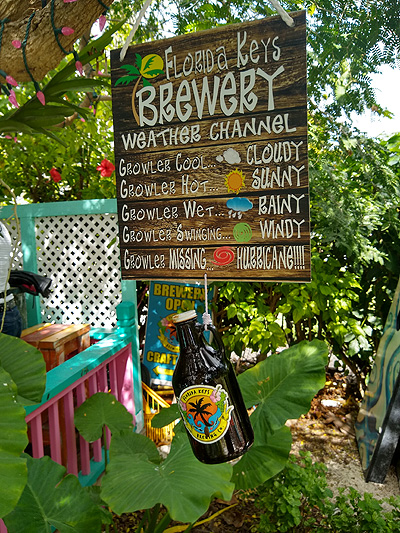 I was
sitting in Islamorada traffic when I heard a voice calling me.... and
it was on the radio. I was
sitting in Islamorada traffic when I heard a voice calling me.... and
it was on the radio.As is/was normal here, traffic was crawling, I had no idea what mile marker I was at, and I was just tired of being behind the same vehicle that used its brakes way too much. I needed a break. First of all, don't let this deter you from visiting the Keys or attending the Winter Star Party. This is normal, and is a part of the experience of driving down almost to the southernmost point of the continental US, which is, of course, at the southwest tip of Key West. If you want to avoid traffic, fly into Key West, or start your journey into the Keys after dinner or later. If not, just be patient, you will get through eventually. It is the price of visiting a very unique part of the United States, and I highly recommend it. I had come from well north of Miami, and on this beautiful Sunday morning I had driven through a bit of rain into the sunny and warm Keys. While crawling along at 5 mph or so, I heard a live spot on the local radio station, 103.1 FM, that was being done from Florida Keys Brewing Company, and they mentioned a barrel-aged stout (with a rather crude name that I don't need to mention here). That was enough to catch my interest and motivate me to visit..... if I could get there. After about ten minutes of listening and looking for a mile marker, I determined that I was about five miles from the brewery and its special event. Come on traffic, let's move - I have a goal! Finally, after some time creeping through Islamorada at slow speeds, and after erroneously turning into the OTHER brewery in Islamorada, Islamorada Beer Company, I finally saw the correct brewery and parked down the road. There was a nice crowd, and iguana races were promised later on. I ordered a Snipe's Stout, and it was quite tasty. I also bought a bottle of the barrel aged version, which should be quite good based on how the regular version tasted. After relaxing a bit, I rejoined the traffic with some beer-aided patience. Don't worry, I only had one beer. As is usual, after one gets through this stretch of one-lane each direction, things open up. Though cruising along at 5-10mph below the speed limit due to slower cars, I was making progress and soon I was approaching Marathon, and then the WSP site on Scout Key. Pleased that I had picked up a snack in Florida City and wasn't starving for lunch, I was ready to help John Pratte (Mr. JPAscrocraft) extract the mirror box of his 32" from his van and help Joe a little bit with assembly of his 32". These two big telescopes would be set up side by side for most of WSP, and both would move a little bit in order to get some shelter from the wind provided by the old wheelhouse, which has not yet been repaired. Everything takes longer in the Keys, but with the very nice Boy Scout camp facilities next door available to us, we didn't need anything else except a little bit of generator power to charge batteries to run telescopes. 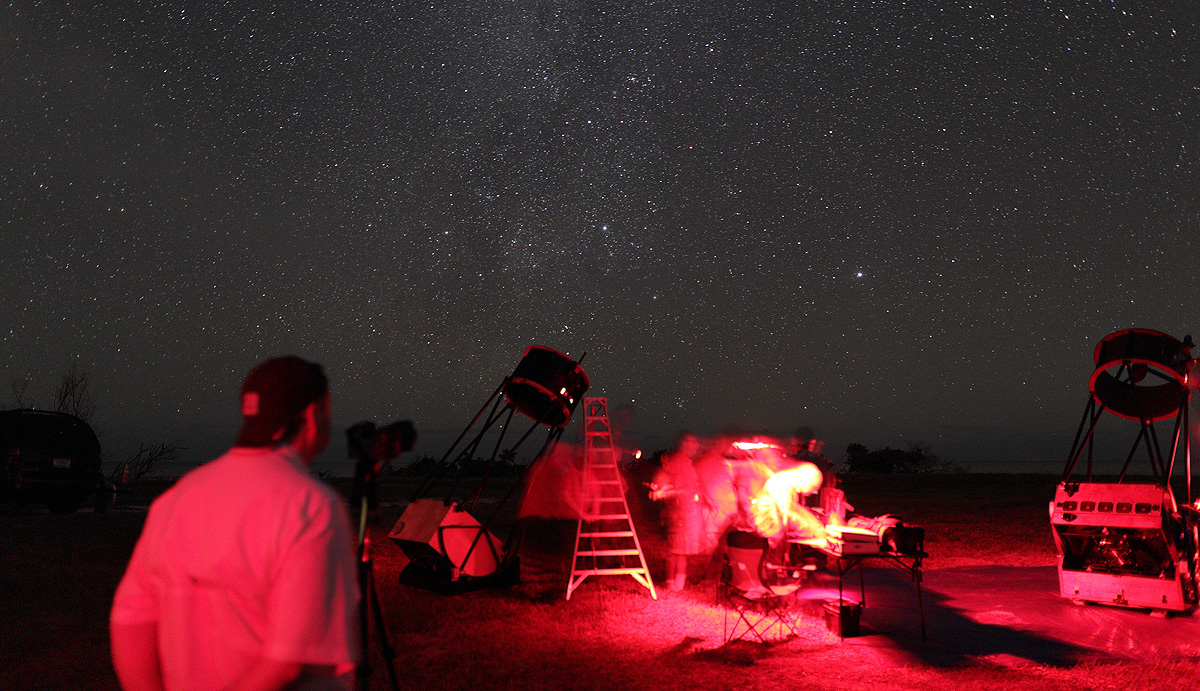 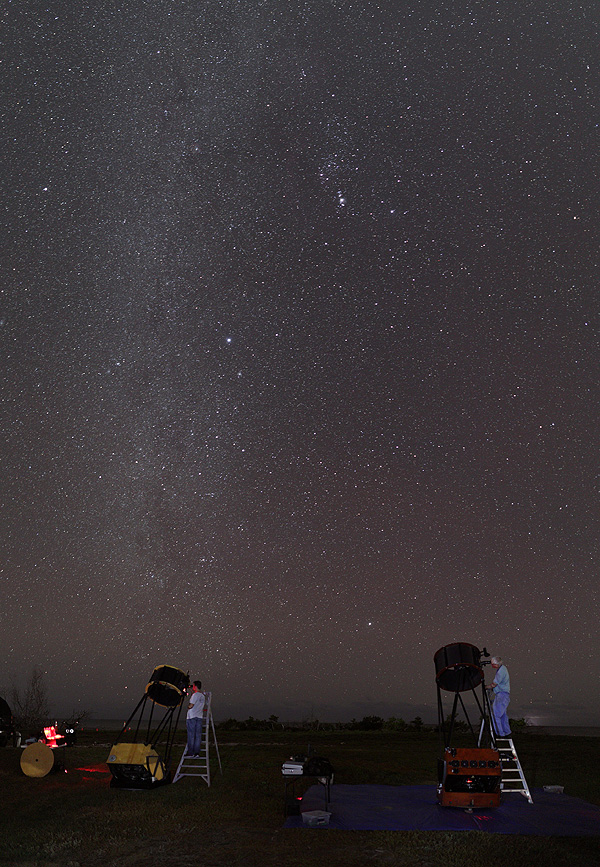 After
catching up with friends and checking out the site a bit, it was time
to get some food, and that food would be seafood, of course. Heading west out of the camp, I had dinner
with some WSP
staff at Boondocks. It was nice to have a good fresh-fish sandwich
again and catch up with them. Sunday night was clear and very
warm, and though I didn't realize it at the time, the bugs were out in
force. Normally this was not an issue, but my legs got chewed
a
bit by multiple species. However, it was worth it, since we
got
to observe with both telescopes and give some great views to some of
the WSP staff who had been hard at work getting ready for the
event. After
catching up with friends and checking out the site a bit, it was time
to get some food, and that food would be seafood, of course. Heading west out of the camp, I had dinner
with some WSP
staff at Boondocks. It was nice to have a good fresh-fish sandwich
again and catch up with them. Sunday night was clear and very
warm, and though I didn't realize it at the time, the bugs were out in
force. Normally this was not an issue, but my legs got chewed
a
bit by multiple species. However, it was worth it, since we
got
to observe with both telescopes and give some great views to some of
the WSP staff who had been hard at work getting ready for the
event.Above, Richard Wright of Software Bisque shoots a photo of John and Joe using their 32" telescopes while I shoot a photo of him. With few others around, I took the opportunity to shoot a vertical panorama of the two 32"s and the sky above with a little bit of white light painting done with my flashlight. As it turned out, later in the event I was very happy that I did it. That three-image panorama is shown at right - Joe is on the ladder of his 32" at left, slightly farther away than John Pratte on the ladder of his 32" at right. The winter Milky Way arches up past Orion to near the zenith, and I never get tired of the view. It was clear for the evening, and then some clouds moved in after midnight. I took the opportunity to call it a night and get situated in the house we were staying in in Marathon. I was soon joined by Charlie Warren and John O'Hara, the other speakers. We visited a bit and then turned in and got some good sleep. Monday dawned sunny and warm, and Charlie and I walked to the Wooden Spoon for a classic diner breakfast. Though small and dated, the food and staff are great, and it's a nice way to have a brunch. By doing this, I ended up eating two meals a day and hopefully not gaining too much weight for the week! Most people arrived on Monday, and by the time I got to the site, most had set up and were ready to observe and take advantage of favorable temperatures by enjoying the views in shorts and a t-shirt. Since the weather proved to be good, the days and nights kind of mixed together into uniform astronomy. However, Monday night was my night to stay up quite late and see Eta Carina and Omega Centauri for the first time since my trip to Australia and New Zealand. One thing that I did not have in the southern hemisphere was nightvision (due to export restrictions), and I took advantage by shooting a number of images of Eta Carina through the 32" telescopes and with the 1X lens on the nightvision unit. These images showed more structure than the nebula did visually through a 32" in Australia, but the subtle beauty and color of it were lost, and the Homonculous, a nebula created during the star Eta Carina's outburst a couple of centuries ago, was just an orange blob instead of a detailed, bright object. See three images below of (left to right) the Flame and Horsehead through the 32" and Eta Carina at 1X, and then two more below those of Eta Carina through a 32". I was thoroughly and pleasantly surprised with the images that I was able to record. Having caught up with friends and achieved my Eta Carina imaging goals, I left the site around 2am and got to sleep by 3am. Tuesday brought more warm weather, and I went for a run in Marathon and cut it short due to the heat. A sinus headache later in the evening cut the night short for me, but a couple of Advil (thanks John!) and the drive back to Marathon helped alleviate that, possibly due to the AC in the car. I got a very good night's sleep in preparation for my talk on Wednesday evening. 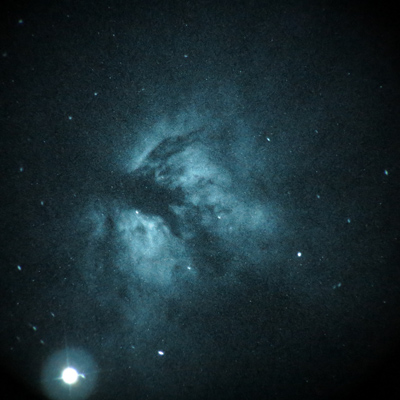 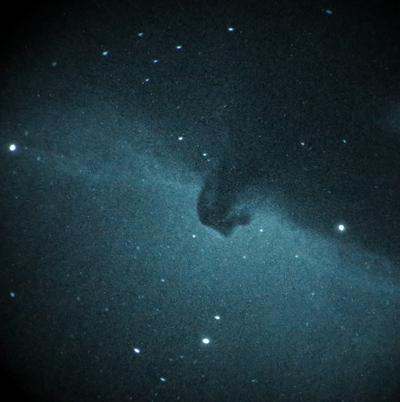 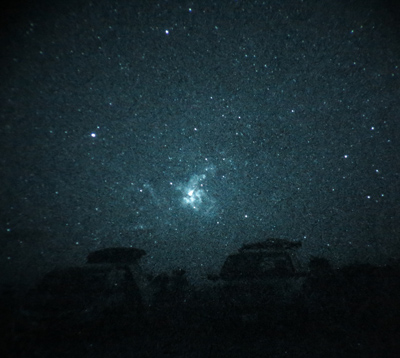 Above: Flame Nebula (left) and Horsehead Nebula (center) through 32" f/3.6 with nightvision, Eta Carina above cars parked on the berm (right) at 1X with nightvision 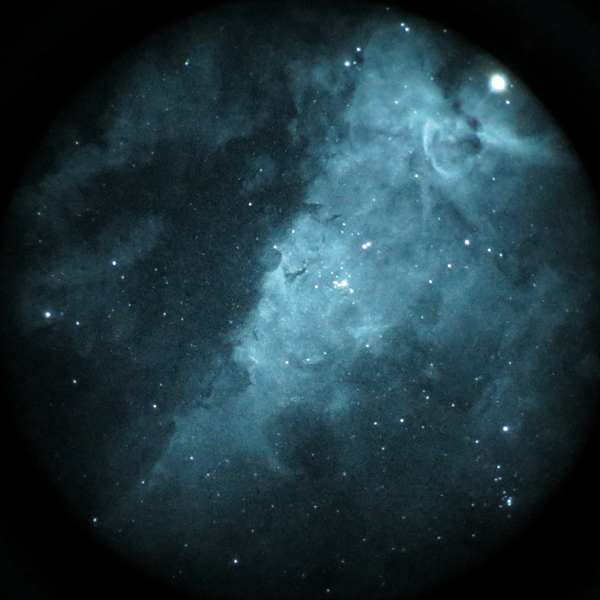 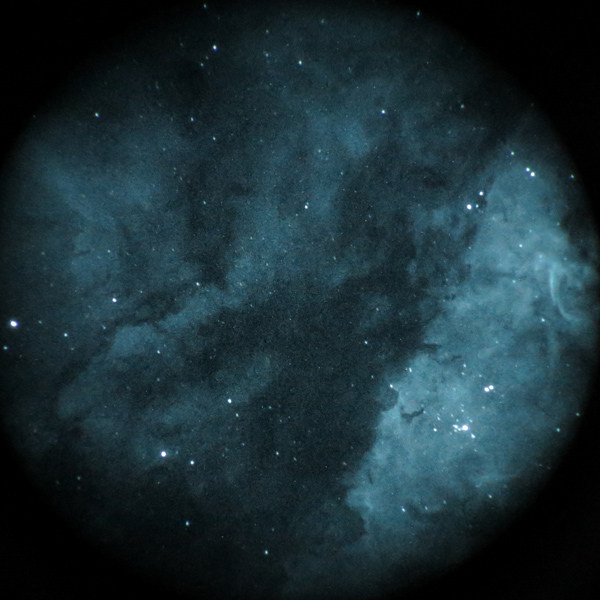 Above: Different areas of the Eta Carina Nebula through 32" f/3.6 with nightvision After adding quite a few photos to my talk, I had a good crowd as the sun set, dusk deepened, and the projector image became bright and easily visible. I had suggested an evening talk after giving daytime talks the year before. As it turned out, it worked out well, and when I finished we had clear skies instead of partly cloudy. We tried to find our red flashlights so we could walk back over to the Girl Scout camp and start observing. Below we see the two 32" telescopes awaiting darkness earlier in the week, as Canopus appears low in the southern sky. 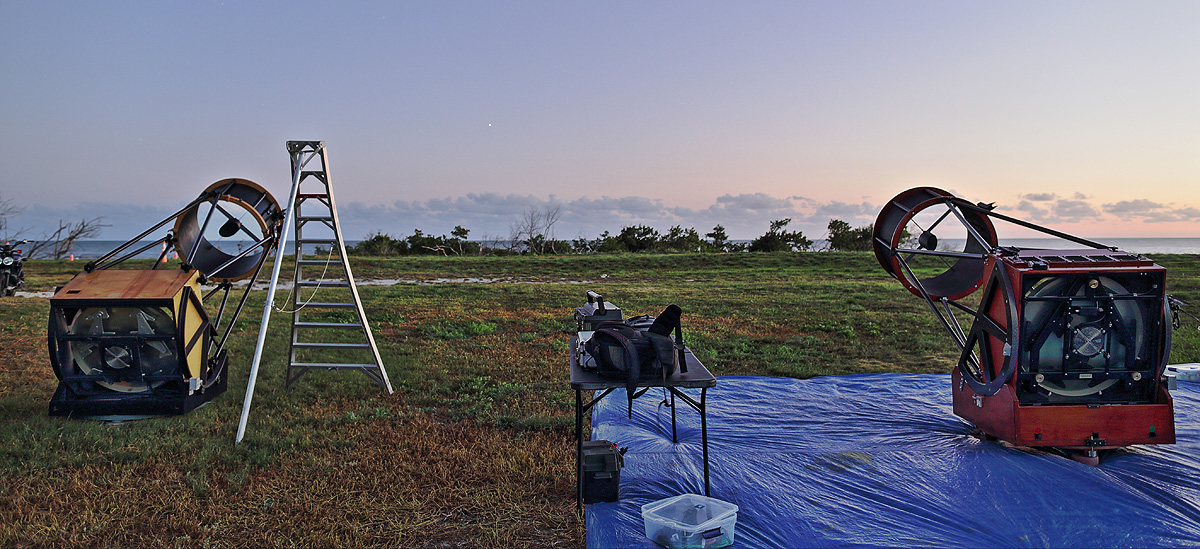 Unfortunately I had to miss the dinner that Howie Glatter's wife put on in his memory because of my talk schedule. We remember him every year, and every time we use one of his laser collimation devices that are without peer, in my opinion. Below John Pratte's 32" is seen at left, Joe's is farther away at center, and Kirk views through his new used 24" f/3.7 as I paint them with a bit of red light. The light dome from Marathon is seen in the distance, but it doesn't affect observing much, since we look at objects higher in the sky. This brightness is also increased by the light of headlights passing during the long exposure. 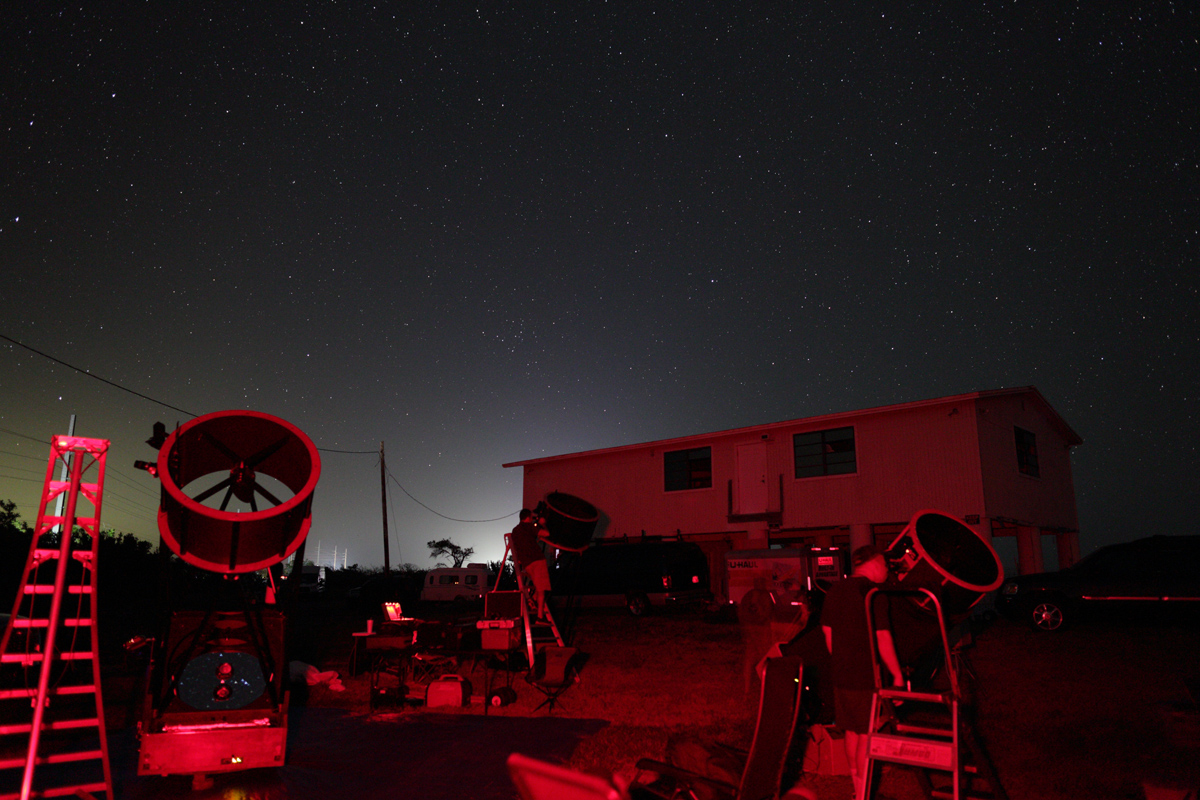 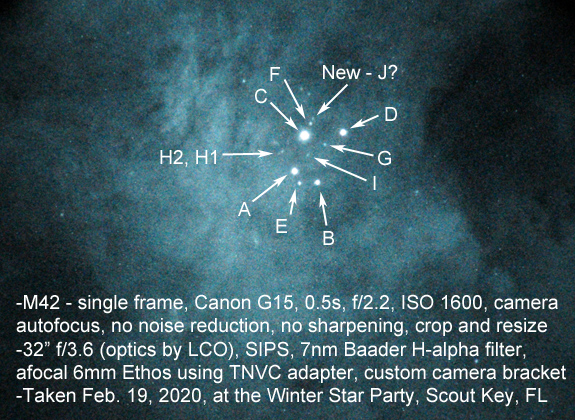 This night was somewhat different because the wind
nearly stopped and the seeing was superb, allowing high power
viewing. This gave me an idea, and soon I was trying to
capture
images of the Trapezium with the nightvision monocular. My
initial looks revealed A through F easily, and G, H1, H2, and I with no
issue. At 1.6" spacing, you could drive a truck between H2
and H2
in moments of good seeing. After all, this is why
we come to the Keys with big telescopes! This night was somewhat different because the wind
nearly stopped and the seeing was superb, allowing high power
viewing. This gave me an idea, and soon I was trying to
capture
images of the Trapezium with the nightvision monocular. My
initial looks revealed A through F easily, and G, H1, H2, and I with no
issue. At 1.6" spacing, you could drive a truck between H2
and H2
in moments of good seeing. After all, this is why
we come to the Keys with big telescopes!However, to my surprise, I noted something extra with the nightvision - an 11th star just above the star designed as F, and this was completely new to me! After viewing with nightvision, I removed it and Joe and I confirmed that we could both see it visually (without the nightvision) in moments of good seeing. I'm calling it J! After a bit of experimenting with a 6mm Ethos, I was successful in getting some good images with my Canon G15 imaging the view in the nightvision eyepiece. With no filter, the brighter components bloomed and obscured fainter stars, so I added a 2" Baader 7nm H-alpha filter, and I could still see all the stars! I just kept shooting frames hoping to catch a really sharp moment, and then I shot some video. After that I shot more frames, and more frames. I was hoping to stack these later on and improve the results. Thrilled with what I had shot, I think I stayed up late enough to see Eta Carina and Omega Centauri on this night, but it could have been Thursday. I was thrilled and had achieved more than my goals. I spent the better part of Thursday processing images and trying to stack the frames from the night before, and I had basically no success. Granted, I am no expert on stacking, but in my defense, the manuals for various programs were not that expert either. I had considered entering an image into the deep sky category of the photo contest, but when I realized that my best images were a few single but very sharp and somewhat noisy frames showing all 11 stars in the Trapezium, I assumed that it would not be up to the quality standards of other images, and I decided not to enter it. However, at right, here is the best frame (to my eye) that I recorded, labeled with the Trapezium star designations. 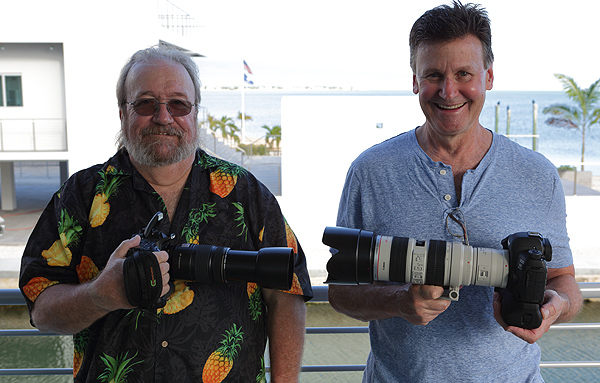 I
will note that the feature just above and left of H1 and H2 is a bright
nebular feature of some sort, and was not stellar when viewed visually.
I will also note that H1 and H2 appeared sharper in other frames,
but this one allowed all stars to be seen fairly clearly. I have
taken the liberty to remove one bright spot (scintillation, probably)
that was present in this frame but not others. Otherwise, no
processing was done on the image seen here. I
will note that the feature just above and left of H1 and H2 is a bright
nebular feature of some sort, and was not stellar when viewed visually.
I will also note that H1 and H2 appeared sharper in other frames,
but this one allowed all stars to be seen fairly clearly. I have
taken the liberty to remove one bright spot (scintillation, probably)
that was present in this frame but not others. Otherwise, no
processing was done on the image seen here.Thursday night - you guessed it - clear again. I visited with friends and observed a bit. Early in the evening I went down by the water and shot a vertical panorama of a sheltered lagoon area, some trees, and the sky above. I used a small tracking mount for this, and planned to stitch the image together later in the evening. Diana from Sky and Telescope had been sent down to see the 32" scopes, and despite some malfunctioning tracking due to an incorrect internal time in the Nexus DSC that had somehow reset itself, we were able to manually track M42, the Horsehead, and the Flame Nebula with nightvision. Soon John had the issue sorted out and tracking was back to normal. I showed her the nightvision unit views at 1X, including many of the h-alpha objects in the sky like Barnard's Loop, the California Nebula, etc. The evening passed by quickly. Later on, Al Nagler stopped by with his nightvision unit, and I started packing up my things and preparing to head back to the house to do some image processing of the latest vertical panorama. It had been a great week, and I was done. I wanted to get some extra sleep because I would have to be on site for the awards and door prize drawing Friday morning and be up early Saturday morning to beat the unavoidable backup caused by the huge nautical flea market that paralyzes keys traffic in Islamorada every February. (Seriously, just build a pedestrian bridge and spare us all the traffic and extra air pollution.) I guess I had had my fill of astronomy, and it was time to get ready to head back to reality, or the part of the world that was not the Florida Keys. However, I still wanted good seafood! Friday dawned slightly cooler and with a strong north wind. Charlie and I went over for one last late breakfast at the Wooden Spoon, and after getting a take out order due to a bit of a wait, I headed over for the door prize drawing and other presentations. See image below of the crowed gathered in every spot of shade (good idea!) and some enjoying the sun. The wind was cool and was blowing out of the north, and it was clear the weather was changing. I was thrilled to hear that my vertical panorama featuring the two 32" scopes and owners from earlier in the week had won the wide-field category. I talked to staff and friends for some time, and after collecting the last of my stuff from the observing field, I headed back to the house as clouds grew thicker. John O'Hara and Charlie Warren were also staying in the house, and they were shooting photos of birds flying by when I returned. See image above for their "lens contest". Charlie won, but he cheated a bit by adding a 2X attachment. The partly sunny day turned completely cloudy, and the temperature continued to drop. 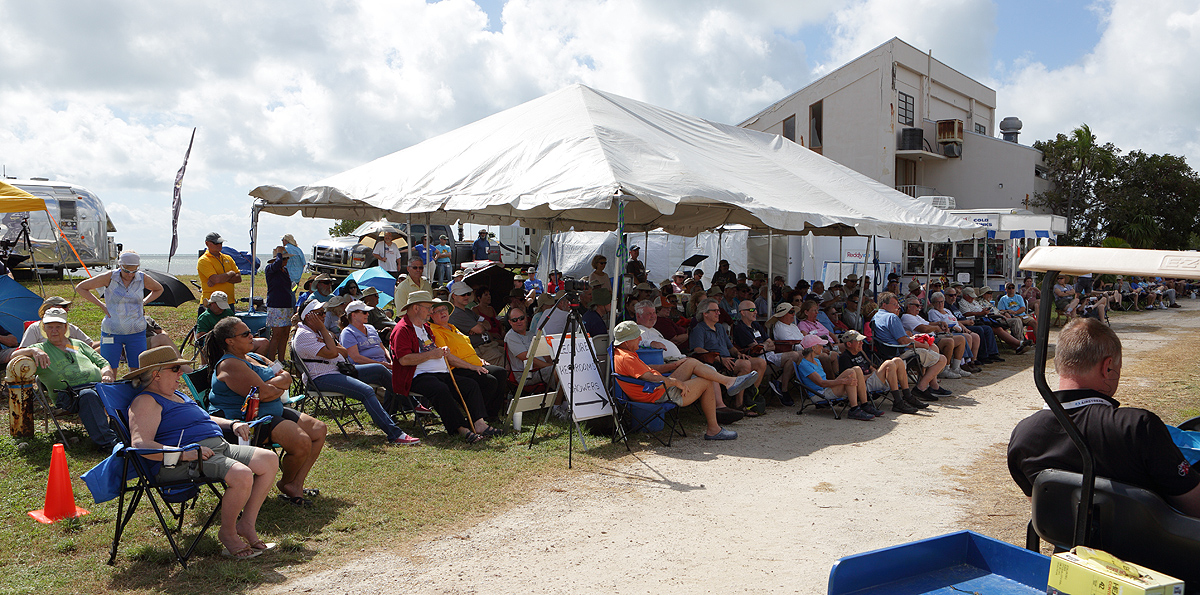 During the week we had gone for several dinners at Keys Fisheries, our favorite spot in Marathon for reasonable pricing and outdoor seating. However, on this cloudy evening we went for dinner at the Marathon Steak and Lobster House, and it was excellent. I had an early-bird special of stuffed snapper, which came with a salad and dessert. Delighted with the food and service, and quite full, we headed back to the house to hang out for a while and enjoy the location. After sharing a few beers with Charlie in an impromptu tasting, we turned in earlier than other evenings since we had to get up and get out of the Keys to avoid the large backup mentioned before. The turnpike was quite busy and appeared to be under construction all the way to Ft. Pierce, but I made it out of the Keys without too much delay and back to my uncle's place a bit after lunch. Another great WSP was behind me, and I hope the seafood cravings aren't too bad before I get back next year...... below is one more image to tempt you to head south. |
Clear, dark, southern skies, no hurricanes, good seeing, and cheers. See you at WSP 2021. -Mike Lockwood, Lockwood Custom Optics 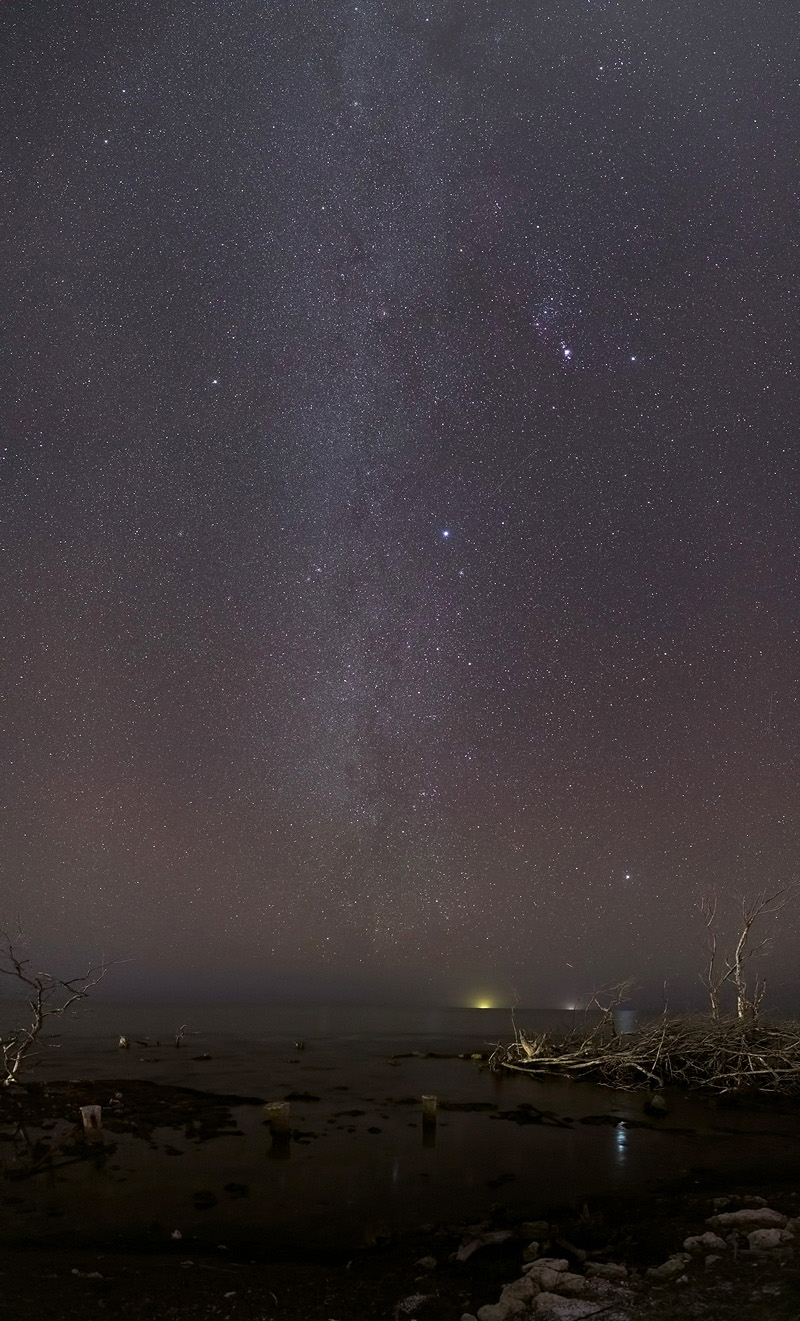 |